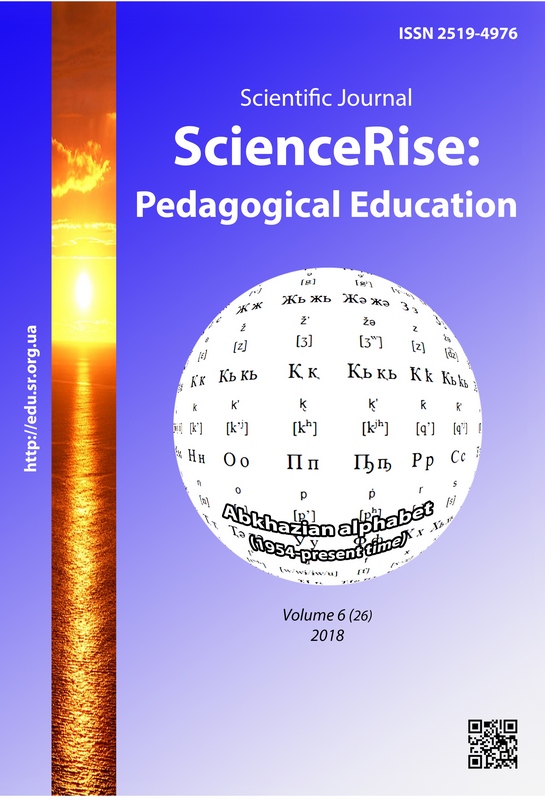Competence model of a cadet of a higher military educational institution
DOI:
https://doi.org/10.15587/2519-4984.2018.143348Keywords:
competence, competency model, military educational institution, ability, skillsAbstract
The article presents the competence model of graduate of the Higher Military Educational Establishment, analyzes the concept of "competence", some social and humanitarian disciplines, which are taught by the students in the specialty "Military Translation" and their provision of graduate competencies.
The necessity of creating a new graduate model of competency model is analyzed. The necessity of forming a political competence of students as part of an integrated competency that form in students the ability to analyze current global trends and geopolitical change, to predict the consequences of these changes for the army and the country in general. It also substantiates the reform of the military standards of personnel motivation, since the process of military service is being optimized, the moral principles and principles upon which the Ukrainian military education was based was unclaimed. An example of a schematic review of a specific competence of a military specialist is presented - "Ability to analyze political events and predict the consequences". The competent model of the military translator according to the educational disciplines taught at the Department of Social and Humanitarian Sciences of the National Academy of the National Guard of Ukraine in the process of professional training is given. It is concluded, that the creation of modern competence models which should become a condition for high-quality vocational training of cadets in higher military establishments of Ukraine, the development of a competent model of a specialist in the field of military translation stimulate further changes in the system of higher military education, especially with regard to the modernization of the content and teaching technologies, proposed in the process of work of a competent model, can be taken as a basis for the training of military translators. The implementation of the competence model proposed in the work has a practical value for the command and teaching staff of higher military educational institutions of Ukraine aimed at obtaining a positive result in the process of providing quality educational services in the system of higher professional education
References
- Ukaz Prezydenta Ukrainy vid 14 bereznia 2016 roku No. 92/2016. Available at: http://www.president.gov.ua/documents/922016-19832
- Polozhennia pro Metodychnu radu Natsionalnoi akademiyi Natsionalnoi hvardii Ukrainy (2014). Kharkiv: Natsionalna akademiya Natsionalnoi hvardiyi Ukrainy.
- Sokolovskyi, V. V. (2011). Kharakterni rysy osobystosti kursantiv ta osoblyvosti yikh navchannia u vyshchykh viiskovykh navchalnykh zakladakh systemy MVS Ukrainy. Zasoby navchalnoi ta naukovo-doslidnoi roboty, 35, 158–164.
- Ishchenko, A. O. (2015). Pedahohichni umovy formuvannia hotovnosti maibutnikh ofitseriv do vykhovnoi roboty z osobovym skladom. Naukovyi ohliad, 7 (17), 73–82.
- Osvita v Ukraini. Available at: http://www.education.ua
- Pro zatverdzhennia Natsionalnoi ramky kvalifikatsiyi. Postanova Kabinetu Ministriv Ukrainy vid 23 lystopada 2011 r. No. 1341. Available at: http://zakon.rada.gov.ua/laws/show/1341-2011-%D0%BF
- Luniachek, V. E. (2012). Otsiniuvannia rezultativ profesiynoi pidhotovky kerivnykh kadriv v umovakh mahistratury do upravlinnia yakistiu osvity. Nasha shkola, 1, 14–21.
- Polozhennia pro orhanizatsiu osvitnoho protsesu v Natsionalniy akademiyi Natsionalnoi hvardiyi Ukrainy (2014). Kharkiv: Natsionalna akademiya Natsionalnoi hvardiyi Ukrainy.
- Pometun, O. (2005). Kompetentnisnyi pidkhid − naivazhlyvishyi orientyr suchasnoi osvity. Ridna shkola, 1, 65–69.
- Prahova, M. Yu., Zaichenko, N. V., Krasnov, A. N. (2015). Ocenka sformirovannosti professional'nyh kompetenciy. Vysshee obrazovanie v Rossii, 2, 21–27.
Downloads
Published
How to Cite
Issue
Section
License
Copyright (c) 2018 Vitaliy Posokhov, Anna Kuruch

This work is licensed under a Creative Commons Attribution 4.0 International License.
Our journal abides by the Creative Commons CC BY copyright rights and permissions for open access journals.
Authors, who are published in this journal, agree to the following conditions:
1. The authors reserve the right to authorship of the work and pass the first publication right of this work to the journal under the terms of a Creative Commons CC BY, which allows others to freely distribute the published research with the obligatory reference to the authors of the original work and the first publication of the work in this journal.
2. The authors have the right to conclude separate supplement agreements that relate to non-exclusive work distribution in the form in which it has been published by the journal (for example, to upload the work to the online storage of the journal or publish it as part of a monograph), provided that the reference to the first publication of the work in this journal is included.








